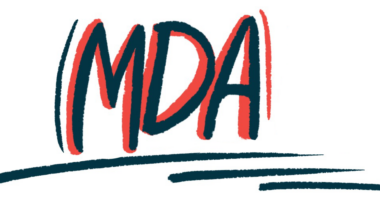MDA 2023: Rozanolixizumab found to work in certain gMG patients
Therapy shown to ease symptoms in trial for those with MuSK antibodies

Treatment with rozanolixizumab — an investigational therapy being developed by UCB for generalized myasthenia gravis (gMG) — worked in a clinical trial to ease symptom severity for a subset of patients who were positive for muscle specific kinase (MuSK) antibodies.
That’s according to analyses from the Phase 3 MycarinG trial (NCT03971422), which found treatment responses and side effect profiles to be similar among this patient subgroup compared with the larger study population.
“Rozanolixizumab improved MG-specific outcomes in MuSK [antibody-positive] gMG, consistent with results in the overall population,” Ali Habib, MD, of the University of California at Irvine, said in an oral presentation at the Muscular Dystrophy Association’s MDA Clinical & Scientific Conference, held March 19-22 in Dallas and virtually.
Habib’s presentation was titled, “Efficacy of rozanolixizumab in muscle-specific kinase antibody-positive generalized myasthenia gravis: Outcomes from the randomized, Phase 3 MycarinG study.” The trial was sponsored by UCB.
Testing rozanolixizumab in people with gMG
Rozanolixizumab is an antibody-based therapy that works to promote the degradation of the self-reactive antibodies that drive gMG. Its aim is to reduce the levels of these antibodies in circulation, and in turn, ease gMG symptoms.
Because its mechanism isn’t specific to one type of antibody, UCB expects the experimental treatment to work not only for patients with antibodies targeting the acetylcholine receptor (AChR) — the most common MG-causing antibodies — but also those with MuSK antibodies. This rare type is often more severe and harder to treat.
The MycarinG study was designed to test rozanolixizumab’s efficacy in 200 adults with gMG. Participants were randomly assigned to receive weekly under-the-skin (subcutaneous) infusions of rozanolixizumab at a dose of 7 or 10 mg/kg, or a placebo, for six weeks. This was followed by an eight-week safety observation period.
Among the study’s participants, 21 were positive for MuSK antibodies. Clinical characteristics for these patients were generally similar to the overall group, Habib noted.
As previously reported, either dose of rozanolixizumab was associated with significant improvements in scores on the MG Activities of Daily Living (MG-ADL) scale, compared with the placebo, across the entire patient group. MG-ADL is a patient-reported measure of symptom severity.
Those gains also were observed in the MuSK subgroup after six weeks. Participants given a placebo had a 2.28-point worsening in MG-ADL, while rozanolixizumab-treated patients experienced an improvement of 7.28 points at the 7 mg/kg dose, and of 4.16 points at the 10 mg/kg dose. That was a relative difference, compared with the placebo, of 9.56 points at the lower dose and 6.45 points at the higher dose.
In the presentation, Habib reported that similar improvements were observed in other measures of disease severity, namely the Quantitative MG (QMG) and the MG Composite (MGC) assessments. QMG is a clinician-rated measure of symptom severity, whereas MGC is a composite measure that takes into account both patient reports and clinical assessments.
Across the entire patient group, those receiving the 7 mg/kg dose of rozanolixizumab saw a significant, 3.9-point improvement in MGC scores relative to the placebo, while those in the 10 mg/kg group experienced a 5.53-point relative improvement.
For MuSK patients, those given the lower dose of rozanolixizumab experienced a 15.54-point improvement compared with the placebo, and those given the higher dose saw a 9.96-point improvement.
Likewise, relative gains in the QMG were 3.48 points at the 7 mg/kg dose, and 4.76 points at the 10 mg/kg dose, compared with the placebo in the entire patient group. For MuSK-positive patients, improvements relative to the placebo were 6.92 points at 7 mg/kg and 3.14 points at 10 mg/kg.
Rozanolixizumab could potentially provide therapeutic benefit in the subset of patients with MuSK [antibody-positive] gMG, who currently have particularly limited treatment options.
Across all three scales and both antibody subtypes, more rozanolixizumab-treated patients were considered treatment responders.
Specifically, while 31.1% of placebo-treated patients achieved at least a two-point improvement in MG-ADL scores — the criteria for a treatment response — about 70% of rozanolixizumab-treated patients at either dose were considered responders.
For those in the MuSK subgroup, 14.3% of placebo-treated patients were considered MG-ADL responders, compared with 100% of those given rozanolixizumab.
The findings overall were similar for the MGC and QMG, with a majority of rozanolixizumab-treated patients being considered treatment responders relative to placebo, regardless of antibody type.
For those in the MuSK subgroup, all 12 rozanolixizumab-treated patients with available data were considered MGC responders after six weeks, and all but one were QMG responders.
The most common side effects were headache, diarrhea, and fever, which were usually mild or moderate. Side effect profiles were similar among the subgroup of MuSK antibody-positive patients.
These finding show that “rozanolixizumab could potentially provide therapeutic benefit in the subset of patients with MuSK [antibody-positive] gMG, who currently have particularly limited treatment options,” Habib concluded.
Following the trial, MycarinG participants can enter into an ongoing open-label extension study (NCT04650854) that’s testing rozanolixizumab’s long-term safety and efficacy. That study is expected to finish later this year.






